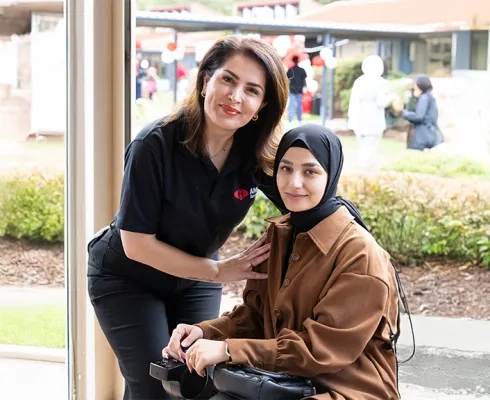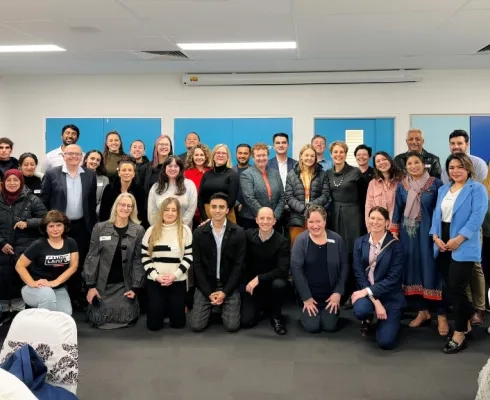AMES Australia – where it all started
The early origins of AMES Australia are revealed in a book written in 1996 by former AMES Director Shirley martin.
The book, New Life new Language’ charts the history of the Adult Migrant English Program from its inception in 1951 and, as part of that, it tells of the earliest days of AMES.
Shirley writes:
As soon as the Victoria Department of Education assumed responsibility for adult migrant education in the state in December 1951 two teachers, Colin McKenzie and Hugh Hawse were seconded and began the task of organising classes under the administration of the Assistant Chief Inspector of Primary Schools.
At the time of the signing of the Commonwealth/State agreement in 1951, there were 125-night continuation classes operating as well as correspondence courses, radio broadcast sessions and day classes at six holding centres in Victoria: Bonegilla, Rushworth, West Sale, Somers, Mildura and Toorak Nurses Hostel.
Growth in the program in the 1970s, after the introduction of full-time intensive courses in 1969, led to changes in the professionalism of the teaching staff as more instructors undertook full-time commitments to the area of teaching English as a Second Language (ESL). Changes in the Teachers’ Tribunal Regulations made possible the employment of teachers as temporary assistants in 1972.
In May 1972 the Association of Teachers of Adult Migrants (ATAM) amalgamated with the Victorian Association for the Teaching of English as a Second Language (VATESOL). In the following year, the Diploma of Migrant Teaching was established as an off-campus opportunity by Armidale College of Advanced Education and provided by teachers with the first of a number of opportunities to gain specialist qualifications.
In the 1970s AMES continued to expand its range of services. The report of the Minister of education in 1972-73 noted several main categories of instruction:
- Continuation classes (260 classes were operating. These showed a trend away from the older inner-city suburbs to the newer areas of migrant density in the west and north-west suburbs. Daytime classes with a special course content structured to women’s needs met a growing demand from Infant Welfare Classes, the Women’s Electoral Lobby and State Mother’s clubs);
- Family classes (groups for migrant families);
- Intensive courses (eight-week courses with 400 students participating);
- Accelerated courses (introduced in 1973 for semi-skilled migrants);
- Part-time, semi-accelerated courses and advanced classes (ten weeks, of 12 hours per week)
- Correspondence tuition
- Industrial English classes (conducted wholly or partly during working hours covering basic English, safety factors and work terminology).
Following the impetus of the Galbally Report in 1978, the level of activity increased and by 1981-82 the program extended to ten major locations in the metropolitan area. Until 1979 the programs in hostels were administered by Language Training Supervisors appointed by the Department of immigration. Many of these supervisors had experience as Shipboard Education Officers. In addition to these major centres, there were many community classes that were established to cater for new demand in different locations. The accommodation varied from schools, church halls, infant welfare centres, to libraries and community centres in metropolitan and country areas.
Several special projects and specific purpose programs were undertaken in the early 1980s. The AMES Annual Report 1981-82 included references to such courses as:
- Pilot six moth courses for migrants with professional qualifications;
- Dialysis patients’ programs at Prince henry’s Hospital;
- Mothers and the school – Italian mothers at Coburg High School;
- Footscray TAFE College – a joint TAFE/AMES bridging course for young adults.
In 1985 an agreement was signed between the Ministry of Education and the Teachers’ Federation of Victoria which, following the 1983 federal election promise, established 151 new permanent teaching positions within the State Support Teaching Service (SSTS) as a first step in ensuring coverage of 65 per cent of all teaching hours by permanent staff.
While the major part of the program delivery was in the metropolitan area, AMES endeavoured to offer tuition to students throughout the state. An AMES Centre was opened in Geelong in the early 1980s and classes were offered in several country cities including Mildura, Morwell, Sale, Shepparton and Wodonga. In the 1980s a move was also made to develop partnerships with local TAFE providers and these partnerships led to AMES contracting services while still maintaining distance learning and volunteer home tutor options for isolated students.
The Campbell Report (1985) identified uncertainty within the program about what the learner-centred needs-based curriculum entailed and a National Curriculum project was undertaken to identify the needs and provide support for teachers in the AMEP. The Frameworks which emerged represented the first encapsulation of an Australian TESOL curriculum paradigm into the form of materials since the ‘Situational English’ course books which had been developed in the 1960s.
The AMES Professional Development Unit encouraged a decentralised approach and general direction and financial support for local initiatives.
In 1988 AMES moved into the Division of Further Education and was, for the first time, part of the adult education sector of the Department. Reporting lines were through the Adult, Community and Further Education (ACFE) to the Office of Training and Further Education (OTFE) while teaching staff were still employed through the Division of Schools Education (DSE).
During the 1990s further significant changes have taken place as AMES has had to adapt to marketplace orientation through the introduction of competitive tendering, first in the area of labour market programs (LMP) and workplace programs (WELL) and in 1997, in the settlement program (AMEP).
Supported by senior officers within the Department, AMES sought increased autonomy through legislation and, when this was not a possibility, became a service agency within the state education system in 1996.
In 1996, AMES gained ISO 9002 accreditation and sought to develop closer working partnerships with local ethnic communities through the appointment of Community Liaison Officers. In 1997 the organization chose to change its name to Adult Multicultural Education Services, reflecting the move into new areas outside the AMEP such as Vocational Education, ELICOS and overseas markets, and the Computer Literacy Centre.




